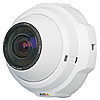Axis Communications 212 PTZ 212 PTZ/-V - User's Manual - Page 13
Other MPEG-4 clients, Stream Types, AXIS 212 PTZ/-V - Video Streams, QuickTime™ & Real Player™
 |
View all Axis Communications 212 PTZ manuals
Add to My Manuals
Save this manual to your list of manuals |
Page 13 highlights
AXIS 212 PTZ/-V - Video Streams Other MPEG-4 clients QuickTime™ & Real Player™ To access the video stream from, for example, QuickTime™ or Real Player™ the following paths can be used: • rtsp:///mpeg4/media.amp • rtsp:///mpeg4/media.3gp Notes • AXIS 212 PTZ/-V supports QuickTime 6.5.1 (or later) and Real Player 10.5 (or later) QuickTime adds latency to the video and audio stream (up to 3 seconds) It may be possible to use other players to view the MPEG-4 stream using the paths above, although this is not guaranteed by Axis = IP address Stream Types Motion JPEG This format uses standard JPEG still images for the video stream. These images are then displayed and updated at a rate sufficient to create a stream that shows constantly updated motion. The Motion JPEG stream uses considerable amounts of bandwidth, but provides excellent image quality and access to each and every individual image contained in the stream. The recommended method of accessing Motion JPEG live video from AXIS 212 PTZ/-V is to use AXIS Media Control (AMC) in Microsoft Internet Explorer in Windows. Note also that multiple clients accessing Motion JPEG streams can use different image settings. MPEG-4 This is a video compression standard that makes good use of bandwidth, and which can provide high quality video streams at less than 1 Mbit/s. Note: All clients viewing the MPEG-4 stream must use the same image settings. The MPEG-4 standard provides scope for a large range of different coding tools for use by various applications in different situations, and AXIS 212 PTZ/-V provides certain subsets of these tools. These are represented as Video object types, which are selected for use with different viewing clients. The supported video object types are: • Simple - sets the coding type to H.263, as used by, for example, QuickTime™ • Advanced Simple - sets the coding type to MPEG-4 Part 2, as used by AMC (AXIS Media Control) When using MPEG-4 it is also possible to control the bit rate, which in turn allows the amount of bandwidth usage to be controlled. CBR (Constant Bit Rate) is used to achieve a specific bit rate by varying the quality of the MPEG-4 stream. When using VBR (Variable Bit Rate), the quality of the video stream is kept as constant as possible, at the cost of a varying bit rate. Important! MPEG-4 is licensed technology. AXIS 212 PTZ/-V includes one viewing client license. Installing additional unlicensed copies of the viewing client is prohibited. To purchase additional licenses, contact your Axis reseller. 13















